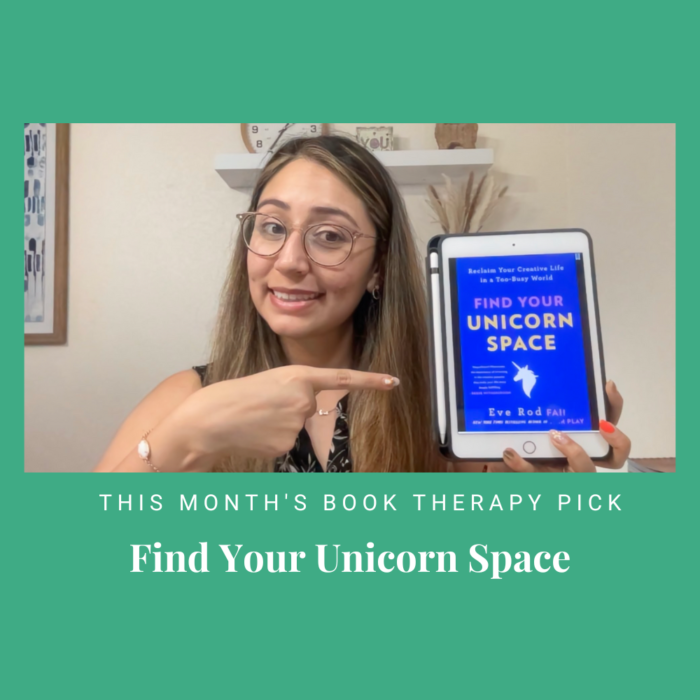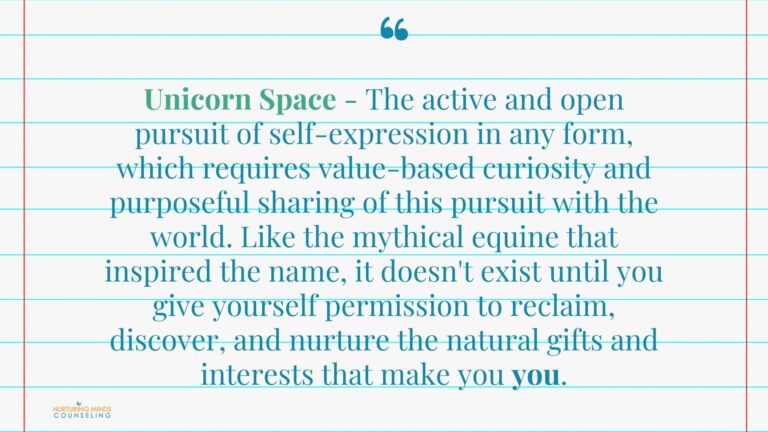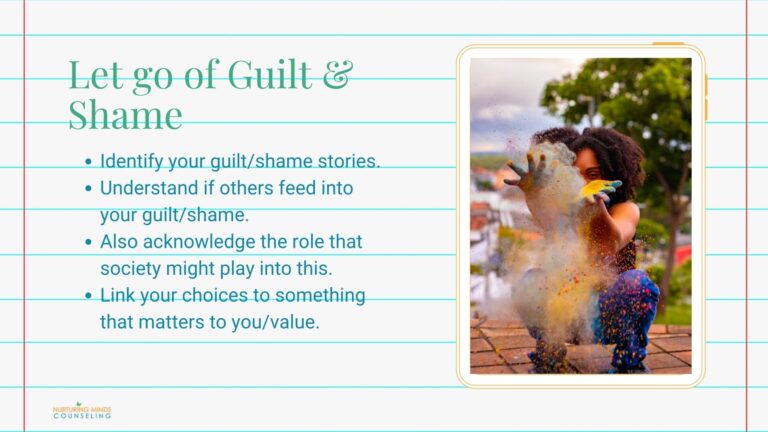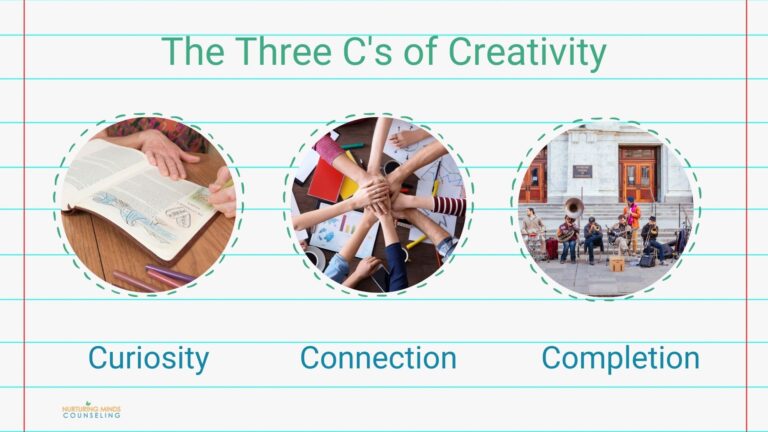Book Therapy: Find Your Unicorn Space

Have you ever felt overwhelmed by the demands of a busy life, leaving little room for creative pursuits? We all deserve a moment to reconnect with our passions and unlock our creative potential. In this blog, I’ll share my thoughts and review some insights from “Find Your Unicorn Space: Reclaim Your Creative Life in a Too-Busy World” by Eve Rodsky to help you reframe how you view creativity. You can also enter to win a copy of the book. Scroll to the bottom. *Only open to USA Residents
Table of Contents
Watch the video on Find Your Unicorn Space
Read blog on Find Your Unicorn Space
This month’s Book Therapy pick is Find Your Unicorn Space: Reclaim Your Creative Life in a Too-Busy World by Eve Rodsky. She’s a pretty popular author at this point due to her first book: Fair Play blew up. I haven’t read it but it’s definitely on my to-read list. Generally, that book is all about how to have a fair balance in your partnership wth balancing tasks. Whereas, Find Your Unicorn Space is all about finding that creative space and taking some of that extra time that you might have now and incorporating creativity into your life.
Find Your Unicorn Summary
The book is broken down into three parts:

Part One: Time for a Reset – This section encompasses chapters one through three. I think she’s laying the groundwork as to what a unicorn space is, why it’s important, and the benefits of incorporating it into your life. She weaves in a lot of stories from people she has interviewed throughout the entire book. That’s the way she goes about writing her book; she interviews a lot of people, she reads a lot, she consumes a lot of research, and then she puts it together. I enjoyed a lot of the stories because I like learning that way.
Part Two: The Rules of Permission – This is from chapters four through six, and it is the rules that you have to give yourself to find/dedicate to your unicorn space. She reviews three general rules in the book. I will highlight one.
Part Three: Cultivating the Three C’s: This is cultivating the three C’s of creativity, which are curiosity, connection, and completion. This is the core of the book and will be part of the insights that I’ll review.
Before we actually go into the three insights, I wanted to give you a definition of what she means by unicorn space.

In case you can’t read the image. “This is the active and open pursuit of self-expression in any form, which requires value-based curiosity and purposeful sharing of this pursuit with the world. Like the mythical equine that inspired the name, it doesn’t exist until you give yourself permission to reclaim, discover, and nurture the natural gifts and interests that make you you.“
What I like about this unicorn space is that it’s all about leaning into authenticity and getting to know yourself. I have discussed spending some time getting to know yourself in the past, and I thought this book was a good tie into that because the unicorn space it about you reclaiming what that is for you. It might be fluid, it might change over time, but it’s an endeavor in you knowing yourself better and giving yourself permission to enjoy that time for yourself.
Insight 1
This insight is about understanding the risks involved with not dedicating time to your unicorn space. The caveat here is that she does tend to gear this book more towards women, so a lot of the stories are from women. However, it is still applicable to men and she does have stories from men.

The first risk is losing yourself, especially if you only dedicate your life to the three p’s: profession, parenting, and partnerships which she says a lot of women do traditionally. Outside of that, you start to notice a sense of absence because you haven’t spent time knowing yourself or spending time and energy on these areas outside of those three p’s.
Relationship dissatisfaction is another risk, so if you feel you’re not allowed to dedicate that time or energy because you have to focus on one of the 3 P’s but your partner somehow still finds ways to focus on other areas of their life, then it can lead to resentful towards your partner.
Other risks are overall well-being and decreased purpose in life. The way she talks about the unicorn space is tying the space to your values and meaning. If you’re not dedicating the time and energy to that, you’re going to notice an impact in your overall sense of feeling good about yourself. If you regularly had a space for yourself, or you are doing something that feels purpose driven with connection and community, that is going to have a positive impact in your life. That might make you a better partner, better parent, and increases resiliency when life gets hard.
The last risk is what you’re modeling for your kids. I do think that, especially as moms, you sacrifice a lot to be a mom. At times, that role may become very central and, not that it’s not important. But it’s also important to model and normalize having other facets of your life. So if/when your kids grow up to be parents, they understand it’s not selfish to want to continue to dedicate time to themselves. It’s a normal human need.
Insight 2
This is one of the permissions in part two. This is related to letting go of guilt and shame. The reason I wanted to highlight this is because I do think that this could be a barrier for you in trying to find your unicorn space. Let go of any guilt and shame that you shouldn’t be dedicating time or energy to, especially if it feels like a frivolous activity or if you have so many more competing responsibilities.
Some tips that I picked as I was reading this chapter is identify your guilt and shame stories, so notice when they show up and when you’re thinking of wanting to spend some time on your unicorn space. For example, maybe you want to dedicate time to a project or a class that would take six weeks, and it just happens to be around the same time that your kid takes another class. That means that you won’t be available and your partner is going to have to pitch in, if your partner agrees to that.
Understand the guilt and shame that could come up for you, and acknowledge that the role that others might feed into this. It’s helpful to identify who the people are that are going to be supportive of your unicorn space. Ideally, your partner will be supportive but if not, don’t worry. She has a whole chapter dedicated to how you move through this with your partner.

Additionally, acknowledge the role that society may play into this guilt. If you’ve ever heard of “mom guilt,” that’s the guilt that you’re taking time away from your kids or your family, and it’s selfish and you shouldn’t do that. Society feeds into that. She references Burnout, the book by the Nagoski sisters. They talk about Human Giver Syndrome and how you give, give, and give, and that there’s this mom guilt that society feeds into. Notice the messages that society sends your way.
Eve Rodsky also has a tool that she gives in the book. I believe she spoke to a researcher that talks about linking your choices to something that matters to you and your value. For instance, “I’m choosing to commit to this class because it’s important for me to dedicate time just for me.” Instead of having this story of guilt and shame from choosing to take time away from family, reframe the way you’re seeing that. I think it’s crucial to tie into your why and your values because it’s going to make the reason why you’re doing that purposeful.
Insight 3
This is all about moving through the three C’s of creativity. This is her described process of finding your unicorn space and moving through it. I’m going to briefly explain each one.

The first C is Curiosity. This is where you take the approach of getting curious about what you think would light you up. What’s something that you’re gravitating towards. Creativity doesn’t have to be in the artistic realm, it can be anything that you find that and meets those criteria of the definition of unicorn space. Spend a little bit of time thinking about what you enjoyed as a kid.
She has exercises throughout the book with questions that you can ask yourself. She also does a values checklist, and you can download the values checklist on her website or find it in the book. This is a part of getting curious and starting to understand that there’s a distinction between curiosity and passion. She has many of quotes about curiosity, and one that I liked was that “Curiosity starts with the itch to explore. ” Try to be as open as possible and don’t set limits for yourself.
The second C is Connection. She says that your unicorn space can’t just be a solo activity. It’s finding a way that this activity somehow connects you to others. This could be helping you build a community or tap into an existing community. She says that this is what’s going to boost up some of that meaning.
I liked that she talked about that because the truth is we are social beings. The reality is that it’s great to have something you’re doing on your own, but somehow linking that to a broader sense of community can help. It doesn’t have to be in a very traditional way. She has different types of connections that she goes through in the book and different ways that you can tap into the sense of connection when you find out which activity you want to dedicate time and energy to.
The final C is Completion. She describes completion as when you share your creative expression with the world. It’s not enough to have an activity that you’re curious and enjoy to do, or even focusing on connecting and building community, it’s also important that you’re then sharing with the world. Sharing with the world can be very unique and distinct to you whatever your activity is.
So, if you’re a dancer, maybe you have a performance that you share. If you’re in a band, you perform. If you create jewelry, you share that with the online community or create an Etsy store. It’s all about sharing this part of yourself with the world, and I think to a certain degree she’s talking about allowing yourself to be seen in this very authentic and unique way. She also talks about it being a cycle of completion she gives an example her cousin and dancing is her thing, and she has a performance. One stage of completion might be finishing that performance by going on stage, but then she’ll feel a new goal where she’ll have another completion cycle. This is ongoing, whether it’s in the same unicorn space or a new one.
As I finish, I’m wondering what would get in the way of you dedicating time and energy to your unicorn space? What would get in the way? Would you get stopped at the curiosity stage, the connection stage, or the completion stage?
I do recommend this book if you are trying to find a way to incorporate creativity in your life, if you’re feeling burnt out, or you’ve lost yourself. This is a great book to help you start to have a little bit more fun and look at how you can build in more creativity in your life. This is something that I’m trying to explore as well.
Next Steps
- Check out my blog for past book picks.
- If you could use some therapy, you’ll find more information on this page to help guide you.
- If you need extra resources and supportive coaching instead of therapy, feel free to explore my coaching business. I’m here to help!
And as always, I hope you continue nurturing your mind, body, and soul, whatever that looks like for you.
This post contains affiliate links, and I may earn a commission if you make a purchase through these links at no extra cost to you. You are under no obligation to use these links.
